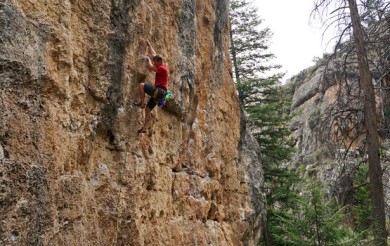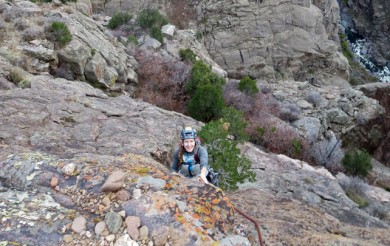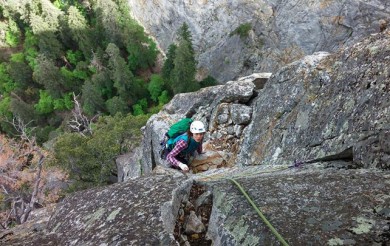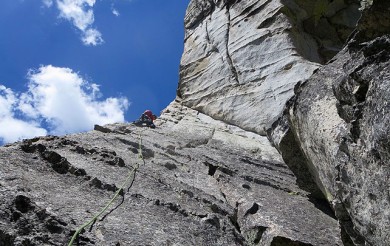The Dangers of Daisy Chains
 Black Diamond put out an excellent post yesterday regarding the dangers of using daisy chains for anything other than aid climbing. The author, BD’s quality control guru, stated how he constantly sees people using them for both cleaning anchors and anchoring in on multipitch routes, which are functions they are not designed for. Most folks, however, assume they are strong enough for these tasks, and so they use them to make life a little easier. The report goes into detail why both of these situations should be avoided, and I think it’s worth looking at in depth.
Black Diamond put out an excellent post yesterday regarding the dangers of using daisy chains for anything other than aid climbing. The author, BD’s quality control guru, stated how he constantly sees people using them for both cleaning anchors and anchoring in on multipitch routes, which are functions they are not designed for. Most folks, however, assume they are strong enough for these tasks, and so they use them to make life a little easier. The report goes into detail why both of these situations should be avoided, and I think it’s worth looking at in depth.
The problem, according to KP, is that when you are attached to an anchor with a daisy, you’ve taken the rope out of the system, and made it completely static. This can set you up for a potentially dangerous shock loading situation, in which the daisy can blow apart and/or you can get severely injured due to the high forces of a static load.
A further problem is noted in that it’s quite easy when shortening your daisy to clip it incorrectly, such that in a shock loaded fall it can blow apart and leave you detached from anything. The video does a great job illustrating this.
QC Lab: Daisy chain dangers from Black Diamond Equipment on Vimeo.
Some would be quick to point out (and rightly so) that the Metolius PAS eliminates this scenario and therefore is the safer option, but it doesn’t change the fact that you are still anchored via a static system. Imagine the following:
Many people I know use a daisy chain or PAS to anchor in on multipitch climbs. Typically they will go in short with the daisy and then back that up with the rope. If this is how you are anchored, and your partner is climbing the next pitch and takes a big fall, you will be violently jerked upwards. The daisy/PAS is static, and you’ll take the full brunt of the fall to your back. Ouch, gonna need to see the chiropractor after that one!
Now, I’ve never liked daisy’s/PAS’s for several reasons, and so I always just use the rope to anchor in at belays, but I’ve often used a sling to go in short, which creates the same problem. It seems the best way to anchor in, to avoid any static loading, is simply using the rope. Some might say this only gives you one point, and you need two to be redundant, but the rope is always just one point when you are using it. And if you really want a backup, you could anchor in short with the rope, and then use a long PAS/sling as a backup. This way, the rope would take the impact of any fall and save you from that chiropractor visit.
For many, this isn’t new news, and it seems this info gets recycled every couple of years, but for good reason. There are still a lot of people out there using these potentially dangerous systems. Of course, you could go your whole life and never have a problem, but climbing is all about calculated risk, so why not stack the odds a little more in your favor?
12 Responses to The Dangers of Daisy Chains
Bulldog Creek Dog Walk (IV WI 4+)
Hayden Carpenter and Tom Bohanon recently repeated an obscure ice climb on the south side of Mt Sopris. Given a brief mention in Jack Robert’s ice guide, Bulldog Creek Walk is described as being 100 meters of WI 4. What they found was seven pitches of ice in a remote setting that makes for one […]
Connect with Us















It’s kind of funny (or scary) this came up because I can honestly say I had no idea about this. A lot of people at my gym (myself included) were taught to clean sport routes with daisy chains.
So what SHOULD we be anchoring in with to clean a route, setting up a top rope or bring up our second? I use a PAS and am always cognizant of the fact that it is not designed to take a dynamic load and move slowly and deliberately when cleaning a sport route or anchoring at a belay.
But if the recommendation is not to use a PAS (which is what I use) or a daisy chain, what would be the best way to anchor in?
Yeah, that one doesn’t make a whole lot of sense to me either. The multipitch thing I get. But the chances of shock loading anything while cleaning are so low, it seems silly to think you can’t safely use a PAS. I always just use two draws, which is the same thing from a load standpoint. I saw a comment on the post from Kolin, maybe someone at BD will respond.
Draws are common and easy to use but ultimately the best thing to tie into an anchor with is the rope.
Draws are fine if you keep your weight on them the whole time.
The rope is best for most situations where you might fall on your anchor connection.
For the rare situation where you can’t do one of those two things, the best alternative is the purcell prusik. It is easy to make out of 6 or 7mm cord, cheap as dirt, and it can withstand high FF falls, unlike the PAS or a daisy. Google around and you should be able to find a video showing how to make one. I don’t use mine often, but when I need it it is great to have.
Daisy chains are stupid, yes, but you need something for anchoring on multipitch rappels. Girth hitching a sling is the easiest and most commonly used option, but it’s made of the same material and is just like a daisy chain when it comes to impact force.
The one place you could get a significant load on an anchor with this system would be rapping, say, a 31+m pitch with a 60m rope — you reach down, clip the anchor, pull your belay device off the ropes, then slip and fall. This could put close to a “factor 2” on a metre of low-stretch material — which could pull a weak anchor, hurt you, or damage your harness.
If you’re really worried about this then the purcell prusik would be an option to consider.
… and with regards to “going in short” with a sling, use a clove hitch to attach the rope to a locking carabiner at the anchor and you’ll never see the need for a sling or daisy chain. If you need to go shorter, just adjust the clove hitch. This can be done without any backup — step up a bit, loosen the clove hitch, pull the appropriate loop to shorten the distance between you and the anchor, then pull the end to tighten it up. infinitely adjustable and dynamic.
With regards to the load of a fall coming on to the belayer, the obvious solution for this is direct a anchor belay, which are especially recommended off bolted anchors. Do the research and practice this technique as it has many applications.
A little bit of dynamic rope won’t solve the violent impact of holding a big whipper with an indirect belay.
sounds harsh but, its just a gaper thing that you do till you learn to clean properly! its in the category of wearing your helmet all day at the crag, which, if you think a rock might fly out of nowhere onto you, is a good idea.
one more…if you are able enough to climb multi-pitch then you should know that you tie in with the rope! DAISIES ARE FOR AID CLIMBING!
daisies are simply slings with 2kn rated pockets inside … ignore those and its a full strength sling … lol
as long as you clip ONE of the pockets you’re fine
if you do take a static fall on something better it be a nylon daisy because
1. its nylon
2. if you didnt clip the last pocket … all the pocket in between will blow lessening the shock
Well, if you are going to fall on something, a purcell prusik is much better than a daisy. It reduces peak load without blowing any stitches or weakening itself for further use on the route. (And not all daisies are made of nylon.)
Seriously, if you think you could get into a situation where you will be falling on a tether, it is worth the time to learn to tie a purcell.
Anyone here ever climbed with two ropes? It’s something we do a lot in the UK, and it solves the problem of being able to tie into more than one anchor point with out much extra hassle. I’ve also found it helps to reduce drag on long wavery routes a lot. The other major benefit is you can set up a retrievable rappel with a 60m length. That purcell prussic looks like an elegant solution though, I’m going to learn how to tie one now.